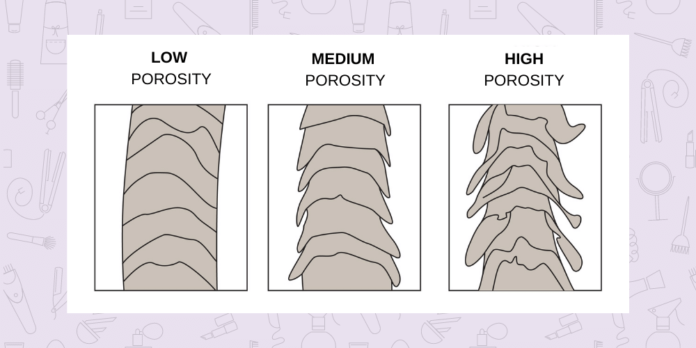Your strands appear like a single, long strip, but it’s actually composed of three layers — cuticle, cortex, and medulla. The cuticle is the outermost layer which is made of plates that overlap each other. If your cuticles are open (high porosity), they will lose moisture faster, leaving your hair frizzy. The cuticles of low porosity hair are tightly packed together and lie flat, leaving no gaps for moisture to enter. Medium porosity is ideal because it holds the healthiest amount of moisture.
None of them are necessarily bad, and using products specifically designed for your porosity level will leave your hair looking it’s best. Ahead, the meaning of hair porosity, how to test your hair porosity, plus the best hair products.
What is Hair Porosity?
In a nutshell, hair porosity is your hair’s ability — or inability — to absorb and retain moisture. It is often due to genetics or specific hair grooming procedures. There are three levels of hair porosity: low, medium and high.
Identifying your hair porosity is important to achieve your healthiest hair possible. Knowing your hair porosity level helps you determine what products are best for you.
Hair Porosity Test
To determine your hair porosity level, start by dunking one of your freshly cleaned, dry loose strand in a cup of water and see if it floats or sinks.
A strand that sinks to the bottom right away is likely high in porosity whereas hair that floats to the top is low in porosity. If it takes a few minutes to sink to the bottom then your hair ranks on a medium level of porosity, so you’re in the clear.
Low Porosity Hair
Low porosity hair doesn’t readily absorb water and hair care treatments, leading to longer washing and drying times. This is because it repels water stopping it from penetrating the hair strand. When low porosity hair finally gets wet, it takes a long time to dry.
OK, but is it bad to have low porosity hair? Not at all. Your hair just takes a minute to absorb moisture. It’s a bit shy when it meets liquids and needs a little push in the right direction.
Since products tend to sit on top of hair that has a low porosity level, build up can take place. To tackle this, we recommend using a clarifying shampoo once a week to get rid of product build-up from your scalp. Also, give your hair hot-oil (using oils like coconut, avocado, and olive) or hot towel treatment on a weekly basis to lift the cuticle so products and moisture can seep in easily.
Products to Try:
• Shea Moisture 100% Extra Virgin Coconut Oil. Shop Now on ulta.com ($16).
• Moroccanoil Treatment. Shop Now on sephora.com ($44).
• Pattern Intensive Conditioner For Tight Textures. Shop Now on ulta.com ($25).
Normal or Medium Porosity Hair
Medium porosity is the sweet spot for hair because it lets moisture in and keeps water out. With a slightly loose cuticle, the hair absorbs just the right amount of moisture and holds on to it for an extended period of time. Therefore, it holds hairstyles well and also requires the least maintenance.
It can easily be taken for granted and the future state of medium porosity hair depends on you and the type of care you provide it with today. Performing regular deep-conditioning treatments (containing proteins, emollients and light, volatile silicones) helps keep such hair balanced and healthy.
Products to Try:
• Living Proof No Frizz Leave-In Conditioner. Shop Now on sephora.com ($27).
• OlaplexNo.3 Hair Perfector. Shop Now on sephora.com ($28).
• Kitsch Satin Pillowcase. Shop Now on mykitsch.com ($19).
High Porosity Hair
High porosity hair have more space between the cuticles or less layering, high porosity is often the driest of the bunch because water just flows in and right back out. The lack of moisture leaves your hair frizzy and prone to breakage and damage.
Aside from using a moisturizing shampoo and conditioner, you should also regularly use a deep conditioning treatment on weekly or biweekly basis which really helps to lock in the moisture. Avoid hot water when shampooing and conditioning. Use lukewarm water instead. Other solutions like more acidic products and protein-based porosity hair care treatments can also help heal and seal a compromised cuticle.
Products to Try:
• Olaplex No. 4 Bond Maintenance Shampoo. Shop Now on sephora.com ($28).
• Ouidad Advanced Climate Control Heat and Humidity Gel. Shop Now on ouidad.com ($10).
• Redken Extreme Anti-Snap Anti-Breakage Leave-In Treatment. Shop Now on ulta.com ($25).
• Design Essentials Almond & Avocado Wash Day Deep Moisture Masque. Shop Now on designessentials.com.com ($15).
Conclusion
There you have it, your ultimate guide to understanding your hair’s porosity! We’ve covered everything you need to know to determine your hair porosity type and how to give your locks the TLC they deserve.
By now, you know that low porosity hair needs a little extra hydration boost, normal porosity hair is the well-balanced type, and high porosity hair can benefit from some extra love to retain moisture.
For more on fashion & beauty, follow Major Mag on Instagram and Pinterest.
